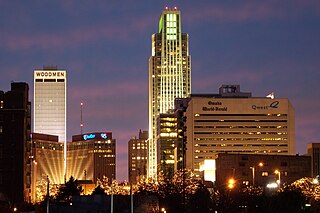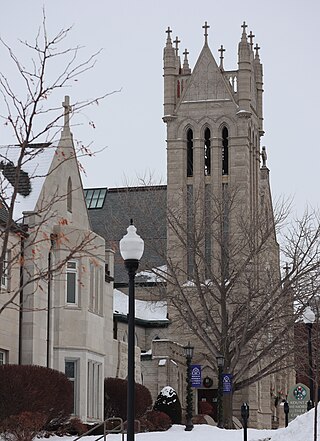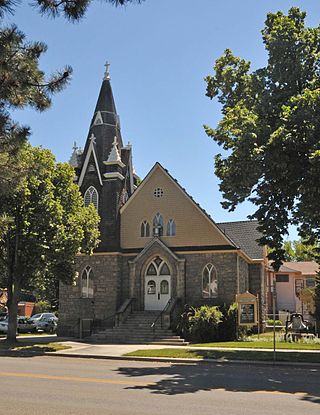
Omaha is the largest city in the U.S. state of Nebraska and the county seat of Douglas County. Omaha is in the Midwestern United States on the Missouri River, about 10 mi (15 km) north of the mouth of the Platte River. The nation's 40th-most populous city, Omaha's 2020 census population was 486,051.

The Evangelical Covenant Church (ECC) is an evangelical Radical Pietistic denomination of Lutheran roots.The denomination has 129,015 members in 878 congregations and an average worship attendance of 219,000 people in the United States and Canada with ministries on five continents. Founded in 1885 in North America by Swedish immigrants, the church is now one of the most rapidly growing and multi-ethnic denominations on the continent.

Swedish Americans are Americans of Swedish ancestry. They include the 1.2 million Swedish immigrants during 1865–1915, who formed tight-knit communities, as well as their descendants and more recent immigrants.

Fredrik Franson was a Swedish-born American evangelical theologian, founder of The Evangelical Alliance Mission (TEAM), of Chicago, Illinois. He has been called "Moody's Swedish disciple".
The Augustana Evangelical Lutheran Church was a Lutheran church body in the United States that was one of the churches that merged into the Lutheran Church in America (LCA) in 1962. It had its roots among the Swedish immigrants in the 19th century.

Culture in North Omaha, Nebraska, the north end of Omaha, is defined by socioeconomic, racial, ethnic and political diversity among its residents. The neighborhood's culture is largely influenced by its predominantly African American community.
The Near North Side of Omaha, Nebraska is the neighborhood immediately north of downtown. It forms the nucleus of the city's African-American community, and its name is often synonymous with the entire North Omaha area. It is bordered by Cuming Street on the south, 30th on the west, 16th on the east, and Locust Street to the north.
Germans in Omaha immigrated to the city in Nebraska from its earliest days of founding in 1854, in the years after the Revolutions of 1848 in the German states. They continued to immigrate to Omaha in large numbers later in the 19th century, when many came from Bavaria and southern Germany, and into the early 20th century. Germans created and maintained a high cultural, social and political profile locally and nationally through the 1930s. In 1890, Germans comprised 23% of Omaha's population. By 1910, 57.4% of Omaha's total population of more than 124,000 identified as being of German descent.
Swedish Australians are Australians with Swedish ancestry, most often related to the large groups of immigrants from Sweden in the late nineteenth century and early twentieth century. The 2011 Census showed 34,029 people who claimed Swedish ancestry, having an increase compared to those 30,375 in 2006. Most Swedish Australians are Lutherans affiliated with the Evangelical Lutheran Church. They form the largest Scandinavian minority in Australia.

Kountze Memorial Lutheran Church is located at 2650 Farnam Street in Midtown Omaha, Nebraska. Organized on December 5, 1858, as Emanuel's Evangelical Lutheran Church, the church is thought to be the first Lutheran congregation organized west of the Missouri River. In the 1920s the church was credited with being the largest Lutheran congregation in the United States.
The Irish in Omaha, Nebraska have constituted a major ethnic group throughout the history of the city, and continue to serve as important religious and political leaders. They compose a large percentage of the local population.
Various ethnic groups in Omaha, Nebraska have lived in the city since its organization by Anglo-Americans in 1854. Native Americans of various nations lived in the Omaha territory for centuries before European arrival, and some stayed in the area. The city was founded by white Anglo-Saxon Protestants from neighboring Council Bluffs, Iowa. However, since the first settlement, substantial immigration from all of Europe, migration by African Americans from the Deep South and various ethnic groups from the Eastern United States, and new waves of more recent immigrants from Mexico and Africa have added layers of complexity to the workforce, culture, religious and social fabric of the city.
Immanuel Medical Center is a hospital located in Omaha, Nebraska. It is part of CHI Health.
K. G. William Dahl was a Swedish-American Lutheran pastor, author and social advocate.

The Evangelical Lutheran Church of Saint Catherine is an Evangelical Lutheran church located at Malaya Konyushnaya Ulitsa 1 in Saint Petersburg, Russia. The building was built in 1885. As it was built by and for Swedish expatriates in Saint Petersburg, it is usually called the Swedish church. The adjacent building is occupied by the Swedish General Consulate.

Erland Carlsson was a Swedish-American Lutheran minister. He was one of the founders and served as president of the Augustana Lutheran Synod.

Hospitals in Omaha, Nebraska have been integral to the city's growth since its founding in 1857. The city has a number of hospitals that were founded by religious groups, and has many medical centers resultant from the mergers of various hospitals. Nebraska is also home to a VA facility that was the only hospital in the United States with a nuclear reactor.

Immanuel Evangelical Lutheran Church is a Lutheran church located in Boise, Idaho. The church was individually listed on the National Register of Historic Places on June 17, 1976. It was included as a contributing property in the Fort Street Historic District on November 12, 1982.
Peter Carlson was a Swedish-American Lutheran Minister who helped found the Augustana Evangelical Lutheran Synod and served as president of the Minnesota Conference for six years.
The Mission Friends was an interdenominational Christian, mostly Pietist and Radical Pietist association in Sweden and among Swedish Americans in the United States, that eventually had an impact on several Protestant denominations and their missionary societies today, even outside of Lutheranism, the Swedish community, and the United States, eventually influencing other communities and forming new independent Radical Pietist, Baptist – especially Swedish Baptist – and later on Pentecostal and Charismatic free church denominations.










